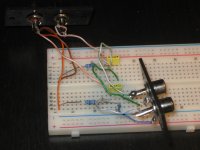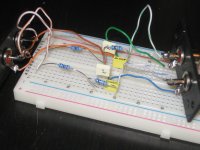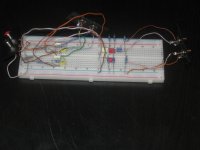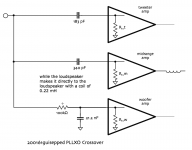I'm trying to build a PLLXO and could use some double checking. I've been using the reference at
Passive Line-Level Crossover
to try to calulate it and checking with the xls from this diyaudio post:
http://www.diyaudio.com/forums/multi-way/12990-pllxo-v-axo-v-pxo-benefits-model.html#post2356273
Ill be using a triode st-70 clone for the highpass amp, which pages found on google says has an input impedance of 470K.
I'm trying to make a second level lowpass at 110hz and a second level highpass at 400hz.
Low pass seems straighforward, my results coincide with the xls.
R1 5.0 k
C1 289.37 nf
C2 28.94 nf
R2 50.0 k
The problem is in the second level high pass.
R1 and C1 are based on the values from the lowpass filter, as I've understood.
Calculation of c2 isn't clear. The issue is the text of the last paragraph:
"If the input impedance gets lower, this has two consequences: the insertion loss gets higher and the xo frequency is shifted upwards. To compensate, calculate C2 in the lowpass as follows:"
I believe this should read ..."calculate C2 in the HIGHpass as follows:"
However, I am not sure if C2 is right in the sheet, it reports .01pF.
The R2 I have calculated is different than the sheet. In fact in the xls, changing amp impedence doesnt affect the R2 value at all, but based on the formula it seems it should. Im getting 56k in my calculation, the sheet gives 50k.
Could I ask someone to help me determine the C2 and R2 component values in a second level highpass PLLXO at 400hz, with an amp impedence of 470k (I hope this figure is right)? With the final results, I can check if there is an error in the xls or if its all correct.
Later, I want to also make a highpass for an audiosector LM3875, but so far haven't found its input impedence documented. Is this documented anywhere or will I need to calculate it?
Thanks!
Andrew
Passive Line-Level Crossover
to try to calulate it and checking with the xls from this diyaudio post:
http://www.diyaudio.com/forums/multi-way/12990-pllxo-v-axo-v-pxo-benefits-model.html#post2356273
Ill be using a triode st-70 clone for the highpass amp, which pages found on google says has an input impedance of 470K.
I'm trying to make a second level lowpass at 110hz and a second level highpass at 400hz.
Low pass seems straighforward, my results coincide with the xls.
R1 5.0 k
C1 289.37 nf
C2 28.94 nf
R2 50.0 k
The problem is in the second level high pass.
R1 and C1 are based on the values from the lowpass filter, as I've understood.
Calculation of c2 isn't clear. The issue is the text of the last paragraph:
"If the input impedance gets lower, this has two consequences: the insertion loss gets higher and the xo frequency is shifted upwards. To compensate, calculate C2 in the lowpass as follows:"
I believe this should read ..."calculate C2 in the HIGHpass as follows:"
However, I am not sure if C2 is right in the sheet, it reports .01pF.
The R2 I have calculated is different than the sheet. In fact in the xls, changing amp impedence doesnt affect the R2 value at all, but based on the formula it seems it should. Im getting 56k in my calculation, the sheet gives 50k.
Could I ask someone to help me determine the C2 and R2 component values in a second level highpass PLLXO at 400hz, with an amp impedence of 470k (I hope this figure is right)? With the final results, I can check if there is an error in the xls or if its all correct.
Later, I want to also make a highpass for an audiosector LM3875, but so far haven't found its input impedence documented. Is this documented anywhere or will I need to calculate it?
Thanks!
Andrew
I believe this should read ..."calculate C2 in the HIGHpass as follows:"
I've fixed that.
dave
Easy solution: download LTSpice and model the response. Start with the basic equation given to determine values. Use a resistor from output to ground equal to your amp's stated input impedance as a load. You can adjust it to see what effect it has on the response of the filter.
Considerations - if impedances of the PLLXO parts are significantly less than the amp input impedance the latter has little effect. However, if the filter presents too low an impedance to the driving stage you could overload the stage and induce distortion. A n active buffer with a high input impedance lets you choose reasonable values for your filter components, which is why I prefer active. Use a jfet buffer if you son't like op amps.
Considerations - if impedances of the PLLXO parts are significantly less than the amp input impedance the latter has little effect. However, if the filter presents too low an impedance to the driving stage you could overload the stage and induce distortion. A n active buffer with a high input impedance lets you choose reasonable values for your filter components, which is why I prefer active. Use a jfet buffer if you son't like op amps.
...I don't see any value in a PLLXO with its problems.
A PLLXO is simplier, much less costly, and avoids all those opamps.
If your system fits the limitions, they are a whole lot better than active anything.
dave
A PLLXO is simplier, much less costly, and avoids all those opamps.
If your system fits the limitions, they are a whole lot better than active anything.
Simplier (sic) does not make better, probably cheaper and avoiding opamps is just a prejudice, without evidence, of dave's. As is the conjecture about being "a whole lot better than active anything".
Frank
In my case...
In my case, simple and cheap with decent sound for this specific build is the goal.
I just happened to start playing with the MA chr-70's while preparing to build some Austin FR horns. With weak bass in a sealed enclosure I was thinking if I should build better enclosure for them or try a sub. Since the MJK H frame with eminence 15a's was cheap and easy, I thought that could be more fun and also useful in future builds. (I'll probably pull the chr's out of the sealed enclosure and put them on an OB soon)
So with the H frame boxes nearly done and the st-70 kit just about ready to fire up (bad choice of verbs?), I'm looking for something to make just these drivers play music together - this isn't the final step but the first. I've even considered a behringer cx2310 but would prefer to make something that will have nice sound.
Actually, I would have built an active crossover / DAC with the miniDSPs if I wasn't really satisfied with my WM8741 based DAC. This is why Im looking for a really light way to cross over in analog.
Andrew
In my case, simple and cheap with decent sound for this specific build is the goal.
I just happened to start playing with the MA chr-70's while preparing to build some Austin FR horns. With weak bass in a sealed enclosure I was thinking if I should build better enclosure for them or try a sub. Since the MJK H frame with eminence 15a's was cheap and easy, I thought that could be more fun and also useful in future builds. (I'll probably pull the chr's out of the sealed enclosure and put them on an OB soon)
So with the H frame boxes nearly done and the st-70 kit just about ready to fire up (bad choice of verbs?), I'm looking for something to make just these drivers play music together - this isn't the final step but the first. I've even considered a behringer cx2310 but would prefer to make something that will have nice sound.
Actually, I would have built an active crossover / DAC with the miniDSPs if I wasn't really satisfied with my WM8741 based DAC. This is why Im looking for a really light way to cross over in analog.
Andrew
I'm trying to build a PLLXO and could use some double checking. I've been using the reference at
Passive Line-Level Crossover
to try to calulate it and checking with the xls from this diyaudio post:
http://www.diyaudio.com/forums/multi-way/12990-pllxo-v-axo-v-pxo-benefits-model.html#post2356273
I have reworked that calculator (and linked it to the PLLXO page)
http://p10hifi.net/planet10/TLS/downloads/PLLXO_Calculator.xls.zip
dave
failed attempt at a prototype
I tried wiring up the low pass side of the pllxo as per the worksheet. As a first test, I want to make just the 1st order low level crossover. The schematic is as easy as can be, but somehow I've done something wrong. I'm sure its a really basic mistake, I'm very new to electronics and just barely starting to get oriented. If you see what I'm doing wrong, please let me know.
The worksheet values I wanted to realize are:
Lowpass
70 hz
N.A. amp resistance (ony used in calculating highpass)
10k resistor
227.3642 nf (I used .22uf)
I built a rough prototype. The solder work is not pretty, I don't know what the RCA sockets are made of, but they just don't heat up. All 8 connections are solid though, I've tested this. I also know that some of the wire shielding is damaged, the wire is from a failed attempt to open cat5 cables. The wires don't touch each other so its not a problem for now.
The only thing this circuit does is add a healthy dose of hum.
On the board I have:
Row2: RCA+ in and 10k (leg1)
Row14: .22uf (leg1), RCA- (in and out)
Row16: RCA+ out, 10k (leg2), .22uf (leg2)
I've tried also reversing the RCA positives and grounds just to be careful, with no change.
I'm sure I'm making a real noob mistake. I've attached a picture of the breadboard. Thanks for helping figure out what I've done wrong.
Andrew
I tried wiring up the low pass side of the pllxo as per the worksheet. As a first test, I want to make just the 1st order low level crossover. The schematic is as easy as can be, but somehow I've done something wrong. I'm sure its a really basic mistake, I'm very new to electronics and just barely starting to get oriented. If you see what I'm doing wrong, please let me know.
The worksheet values I wanted to realize are:
Lowpass
70 hz
N.A. amp resistance (ony used in calculating highpass)
10k resistor
227.3642 nf (I used .22uf)
I built a rough prototype. The solder work is not pretty, I don't know what the RCA sockets are made of, but they just don't heat up. All 8 connections are solid though, I've tested this. I also know that some of the wire shielding is damaged, the wire is from a failed attempt to open cat5 cables. The wires don't touch each other so its not a problem for now.
The only thing this circuit does is add a healthy dose of hum.
On the board I have:
Row2: RCA+ in and 10k (leg1)
Row14: .22uf (leg1), RCA- (in and out)
Row16: RCA+ out, 10k (leg2), .22uf (leg2)
I've tried also reversing the RCA positives and grounds just to be careful, with no change.
I'm sure I'm making a real noob mistake. I've attached a picture of the breadboard. Thanks for helping figure out what I've done wrong.
Andrew
Attachments
You have totally miswired it. It may help you to use the -bus as your ground. As you have assembled this thing you have no DC ground connection between input and output.
For a low pass you should have input and output grounds connected to one end of the cap. The input connects to one end of the resistor, the other end of the resistor connects to the output and the non grounded end of the cap.
For a low pass you should have input and output grounds connected to one end of the cap. The input connects to one end of the resistor, the other end of the resistor connects to the output and the non grounded end of the cap.
Thanks Bob, with your help I got it working. I then went on to make a second order low level crossover. I forgot to take a picture of the 1st level, but in case it helps anyone, here is a picture of the 2nd level low level crossover. (It could be made a lot prettier, but it works...)
How much of an effect do the capacitors in this xo have on sound? Are there any recommended capacitor brands people would recommend for a pllxo? I used whatever the local electronics store around the block had on hand, so I could figure out the values which sounded best in my room. I'll build something "permanent" once I determine this. Should I try to order some quality capacitors or at this level does it not matter much?
How much of an effect do the capacitors in this xo have on sound? Are there any recommended capacitor brands people would recommend for a pllxo? I used whatever the local electronics store around the block had on hand, so I could figure out the values which sounded best in my room. I'll build something "permanent" once I determine this. Should I try to order some quality capacitors or at this level does it not matter much?
Attachments
I've found a fairly significant difference between polyester (MKT) and polypropylene (MKP - preferred). I also heard subtle but noticeable improvement when going from metalized film to stacked film and foil. Stacked film is generally only available in small values which relegates them to high frequency use.
Some prefer teflon and polystyrene, but haven't really noticed much difference. Perhaps my ears or tweeters aren't up to the task, or the opa2134s kill the difference.
Some prefer teflon and polystyrene, but haven't really noticed much difference. Perhaps my ears or tweeters aren't up to the task, or the opa2134s kill the difference.
The XO with highpass
Here's a shot of the PLLXO now that I've added a 2nd order highpass. The highpass is followed up with a shunt attenuator (at least that was the goal )
)
Hopefully I've wired this one right! At the very least its effective, indeed with test frequencies its doing pretty much what it should.
That said, I can't even listen to it. Music is so flat that I can't even begin to describe it. Arthur Salvatore goes on about the importance of "sound floor" (noise floor) on his personal website, HIGH-END AUDIO and Arthur Salvatore. This little toy demonstrates the principle perfectly!
I'm using an xstreamer with optical out to an audio-gd fun DAC (wolfram WM8741 based) to a triode electronics st-70 (with all NOS tesla tubes, including ecc802s and ef806s, sonic bliss!) connected to MarkAudio chr-70's in IKEA bowl spherical sealed cabinets. By itself the detail is just wonderful. Add in the crossover and dull doesn't begin to describe the sound. Lowpass is handled by a brianGT chipamp driving H frame OB Eminence Alpha 15A's, by the way.
So, for now I've pulled it out. I'll play with the xo a bit, and try to see if the low quality sound is due to a mistake I might have made. If anyone sees a problem with the way I wired it, let me know! I'll have to get a mic so I can do a frequency response test to make sure the component values are appropriate. Then I'll buy some good quality caps to test it with.
I'm also thinking that I could do the XO while still in digital: with a miniDSP outputting highs to optical to my current DAC, as its sound is quiet good, and use the miniDSP DAC for lows to the chipamp.
The pllxo though will still be interesting if I ever decide to get a turntable, so I think its an experiment worth continuing. A possible modification later would be to add a switch to each filter altering the resistor pairs, to be able to alter the crossover frequencies on the fly. Also, adding a buffer after the highpass so that you have a known impedance, allowing the highpass amp to be swapped, might be an interesting step later. In all it seems to have the potential to be a useful piece of gear.
I'll post as I make progress, since there seems to be little written up about pllxos.
Here's a shot of the PLLXO now that I've added a 2nd order highpass. The highpass is followed up with a shunt attenuator (at least that was the goal
Hopefully I've wired this one right! At the very least its effective, indeed with test frequencies its doing pretty much what it should.
That said, I can't even listen to it. Music is so flat that I can't even begin to describe it. Arthur Salvatore goes on about the importance of "sound floor" (noise floor) on his personal website, HIGH-END AUDIO and Arthur Salvatore. This little toy demonstrates the principle perfectly!
I'm using an xstreamer with optical out to an audio-gd fun DAC (wolfram WM8741 based) to a triode electronics st-70 (with all NOS tesla tubes, including ecc802s and ef806s, sonic bliss!) connected to MarkAudio chr-70's in IKEA bowl spherical sealed cabinets. By itself the detail is just wonderful. Add in the crossover and dull doesn't begin to describe the sound. Lowpass is handled by a brianGT chipamp driving H frame OB Eminence Alpha 15A's, by the way.
So, for now I've pulled it out. I'll play with the xo a bit, and try to see if the low quality sound is due to a mistake I might have made. If anyone sees a problem with the way I wired it, let me know! I'll have to get a mic so I can do a frequency response test to make sure the component values are appropriate. Then I'll buy some good quality caps to test it with.
I'm also thinking that I could do the XO while still in digital: with a miniDSP outputting highs to optical to my current DAC, as its sound is quiet good, and use the miniDSP DAC for lows to the chipamp.
The pllxo though will still be interesting if I ever decide to get a turntable, so I think its an experiment worth continuing. A possible modification later would be to add a switch to each filter altering the resistor pairs, to be able to alter the crossover frequencies on the fly. Also, adding a buffer after the highpass so that you have a known impedance, allowing the highpass amp to be swapped, might be an interesting step later. In all it seems to have the potential to be a useful piece of gear.
I'll post as I make progress, since there seems to be little written up about pllxos.
Attachments
You might try a buffer between your PLLXO and the attenuator. I prefer active filters.
The issue with your sound could also be a slight level mismatch. Measure your response.
Using your DAC after the miniDSP could cause timing issues. The signal will take a finite time to be processed by your DAC which may be noticeably different than the time it takes the lows in the miniDSP dac. Way above my head, but having identical DACs using the same clock reference is probably preferable.
The issue with your sound could also be a slight level mismatch. Measure your response.
Using your DAC after the miniDSP could cause timing issues. The signal will take a finite time to be processed by your DAC which may be noticeably different than the time it takes the lows in the miniDSP dac. Way above my head, but having identical DACs using the same clock reference is probably preferable.
Pllxo
Sorry for my English, I've been using a pllxo for about 15 years, but the results of the c and r values derived from the formulas gave me a horrible sound. For several years I have decided to use only my ear. Today i use an av nad t773 that has the preout outputs and i used to delete the wiring. In the specific use, a direct capacitor without resistance to the 183 pf tweeter, a 340 pf direct for the midrange passover, while the loudspeaker makes it directly to the loudspeaker with a coil of 0.22 mH, as far as the woofer uses a resistance in 100kohm series and a 21.2 nF capacitor. Capacitors are all silver-plated. The sound is really natural. The question is why do the formulas tell me that with these values I have absurd cuts while listening tells me that it is correct? I found the value of the capacitors for medium and tweeters by setting the compensators first and once adjusted I measured the capacitance with a capacitance meter. I assure you that the result is spectacular. The casks are self-built with dynaudio components ie md130 tweeter, mid md140 and mw180 woofer with liters of about 60 liters. For ideex exchanges my email is giuseppemurena61@gmail.com. Greetings
Sorry for my English, I've been using a pllxo for about 15 years, but the results of the c and r values derived from the formulas gave me a horrible sound. For several years I have decided to use only my ear. Today i use an av nad t773 that has the preout outputs and i used to delete the wiring. In the specific use, a direct capacitor without resistance to the 183 pf tweeter, a 340 pf direct for the midrange passover, while the loudspeaker makes it directly to the loudspeaker with a coil of 0.22 mH, as far as the woofer uses a resistance in 100kohm series and a 21.2 nF capacitor. Capacitors are all silver-plated. The sound is really natural. The question is why do the formulas tell me that with these values I have absurd cuts while listening tells me that it is correct? I found the value of the capacitors for medium and tweeters by setting the compensators first and once adjusted I measured the capacitance with a capacitance meter. I assure you that the result is spectacular. The casks are self-built with dynaudio components ie md130 tweeter, mid md140 and mw180 woofer with liters of about 60 liters. For ideex exchanges my email is giuseppemurena61@gmail.com. Greetings
av nad t773 that has the preout outputs, a direct capacitor without resistance to the 183 pf tweeter, a 340 pf direct for the midrange passover, while the loudspeaker makes it directly to the loudspeaker with a coil of 0.22 mH, as far as the woofer uses a resistance in 100kohm series and a 21.2 nF capacitor.
Do i have the inductor in the right place?
Then a mix of PLLXO & passive XO?
Looks pretty standard, but for the mid LP being passive.
dave
Attachments
- Status
- This old topic is closed. If you want to reopen this topic, contact a moderator using the "Report Post" button.
- Home
- Loudspeakers
- Multi-Way
- Trying to build a PLLXO



